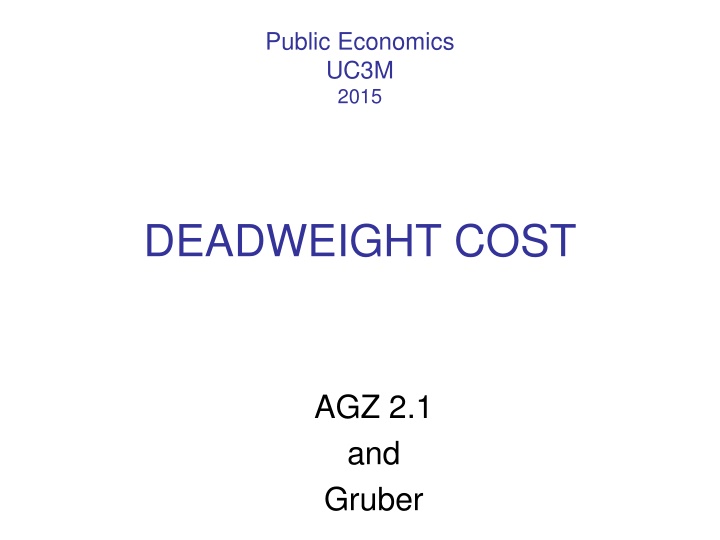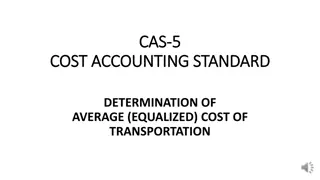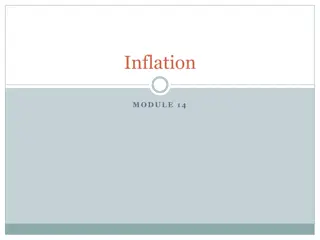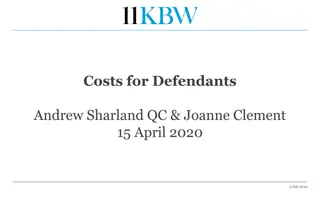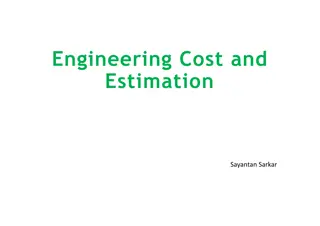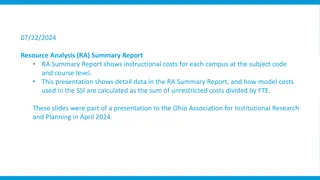Analysis of Deadweight Costs in Public Economics
The concept of deadweight costs in public economics, focusing on the efficiency impact of government policies such as taxes for revenue and income redistribution. Learn how these policies affect welfare and efficiency, and strategies to minimize efficiency costs.
Download Presentation

Please find below an Image/Link to download the presentation.
The content on the website is provided AS IS for your information and personal use only. It may not be sold, licensed, or shared on other websites without obtaining consent from the author.If you encounter any issues during the download, it is possible that the publisher has removed the file from their server.
You are allowed to download the files provided on this website for personal or commercial use, subject to the condition that they are used lawfully. All files are the property of their respective owners.
The content on the website is provided AS IS for your information and personal use only. It may not be sold, licensed, or shared on other websites without obtaining consent from the author.
E N D
Presentation Transcript
Public Economics UC3M 2015 DEADWEIGHT COST AGZ 2.1 and Gruber
Deadweight cost: effect of policies on size of the pie Focus in efficiency analysis is on quantities, not prices
Government raises taxes for one of two reasons: 1. To raise revenue to finance public goods 2. To redistribute income But to generate $1 of revenue, welfare of those taxed falls by more than $1 because the tax distorts behavior How to implemente policies that minimize these efficiency costs?
Size of the welfare loss? Deadweight loss: the equivalent in $ to the utility reduction due to the tax, above the reduction cretaed by a lum-sump tax. We assume perfect competition. Remember the link between price, marginal utility and marginal cost. Deadweight loss related to the substitution effect. First, we analyze it using indifference curves. Suppose constant marginal cost, and a numerarie, Y, with price 1.
Y We introduce tax t G Slope: -px (1+t) B A slope: -px U0 U1 H xB xA X
Equivalent variation: How many units of Y (i.e. money) is the consumer willing to pay to avoid the tax t?
Y Tax t G What would happen with a lump-sum tax? W F Eg B D E A C U2 U0 U1 H xB xC xA X
In general, the higher the slope of the indifference curve the higher the deadweight loss, bacuse of the substitution effect We study next the same welfare loss but using the demand and supply curves.
p We introduce tax t N B px(1+t) O1 M P O0 px X(p,R) xB xA X
Consider the following demand curve: Xc (p, U1). This is the compensated demand function (Hicksian demand): demand of x that minimizes the expenditure while delivering a fixed level of utility U1
p Change in welfare: NBCM Tax revenue: NBPM Excess burden : BCP N B px(1+t) O1 Eg M P C O0 px X(p,R) Xc(p,U1) xB xC xA X
In empirical work: we take the regular demand functions as an approximation to the compensated demand function. This approximation is a good one if : small income effect-> small difference between XA and XC.
Method often used in empirical work: Assume that the segment BC in the compensated demand function is linear. Deadweight loss: the triangle of area 1 ( )( ) + 1 ( ) x x p t p B A x x 2 We can write it as: 1 C x p t x 2 The price elasticity of the compensated demand at C is C x x = C x c e p x p x
So that: 1 g= 2t C x 11 ( ) E e p x x C 2 Then deadweight loss is higher when: The higher the compensated price-elasticity The higher the before-tax expenditure in X The higher the tax rate (notice that we have t square)
Figure 2 Demand is fairly inelastic, and DWL (a) Inelastic Demand is small. (b) Elastic demand Demand is more elastic, and DWL is larger. P P S2 S2 S1 S1 B P 2 P 1 B DWL DWL P 2P 1 A A C 50 Tax 50 Tax C D1 D1 Q Q Q2 Q1 Q2 Q1
This point about DWL rising with the square of the tax rate can be illustrated graphically Marginal deadweight loss is the increase in deadweight loss per unit increase in the tax.
Figure 3 S 3 The next $0.10 tax creates a larger marginal DWL, BCDE. P S2 S1 D P 3 The first $0.10 tax creates little DWL, ABC. B P 2P 1 A C $0.10 E $0.10 D1 Q Q3 Q2 Q1
The insight that deadweight loss rises with the square of the tax rate has implications for tax policy with respect to: Preexisting distortions Progressivity Tax smoothing
Taxation and economic efficiency Deadweight loss and the design of efficient tax systems Preexisting distortions are market failures that are in place before any government intervention. Externalities or imperfect competition are examples. Figure 4 contrasts the use of a tax in a market without any distortions and in one with positive externalities.
Figure 4 P S2 P S2 In a market with a preexisting distortion, taxes can create larger (or smaller) DWL. S1 S1 SMC B G E A D C F H D1 D1 Q Q Q 0 Q 2 Q 1 Q2 Q1 No positive externality Positive externality
Imposing the tax in the first market, without externalities, results in a modest deadweight loss triangle equal to BAC. When an existing distortion already exists where the firm is producing below the socially efficient level, the deadweight loss is much higher. The marginal deadweight loss from the same tax is now GEFH. Of course, if there were negative externalities, such a tax would actually improve efficiency.
Taxation and economic efficiency Deadweight loss and the design of efficient tax systems This insight about deadweight loss also demonstrates that a progressive tax system can be less efficient. Consider two tax systems one a proportional 20% payroll tax, and the other a progressive tax that imposes a 60% rate on the rich, and a 0% rate on the poor. Figure 5 shows these cases.
Figure 5 S3 S2 S 2 Wage (W) Wage (W) S1 S1 DWL increases with the square of the tax rate. Smaller taxes in many markets are better. G W3=23.90 E B W2=11.18 W1=10.00 W2=22.36 W1=20.0 0 D A F C D1 D1 I Hours (H) Hours (H) H2=894 H1=1,000 H3=837 H2=894 H1=1,000 Low Wage Workers High Wage Workers
Taxation and economic efficiency Deadweight loss and the design of efficient tax systems Under the proportional system the efficiency loss for society is the sum of two deadweight loss triangles, BAC and EDF. Under the progressive system, the efficiency loss is the triangle GDI that is, it adds the area GEFI but does not include BAC. Table 1 puts actual numbers to the picture.
Table 1 Low wage worker Panel A A lower proportional tax creates less DWL than the higher progressive tax. High wage worker Panel B Tax Rate Below $10,000 Tax Rate Above $10,000 Hours of labor supply Deadweight Loss from Taxation Hours of labor supply Deadweight Loss from Taxation Total Deadweight Loss No Tax 0 0 1000 (H1) 0 1000 (H1) 0 0 Proportional Tax 20% 20% 894 (H2) $115.71 (area BAC) 894 (H2) $231.42 (area EDF) $347.13 (BAC + EDF) Progressive Tax 0% 60% 1000 (H1) 0 837 (H3) $566.75 (area GDI) $566.75 (EDF + GEFI)
In this case, a proportional tax is more efficient. The large increase in deadweight loss arises because the progressive tax is levied on a smaller tax base. In order to raise the same amount of revenues on a smaller base, the tax rate must be higher meaning a higher marginal DWL. This illustrates the larger point that the more one loads taxes onto one source, the faster DWL rises. The most efficient tax systems spread the burden most broadly. Thus, a guiding principle for efficient taxation is to create a broad and level playing field.
The fact that DWL rises with the square of the tax rate also implies that government should not raise and lower taxes, but rather set a long-run tax rate that will meet its budget needs on average. For example, to finance a war, it is more efficient to raise the rate by a small amount for many years, rather than a large amount for one year (and run deficits in the short-run). This notion can be thought of as tax smoothing, similar to the notion of individual consumption smoothing.
Example It may be easier to approximate the DWL from point B. In this case, the equivalent eq. to (11) is 1 2 2 = B x E e q x t g x B Where the elasticity is calculated at B and qx =px (1+t) and t~=t/(1+t) Example on taxes on cigarretes. Demand (in 2003) $7.625 m Tax rate 250% Price-elasticity (compensated demand) -0.89 Using the fromula we get Eg =$1731 m This is 32% of the total tax revenue
Application: savings, labor supply Y= consumption today, X= consumption tomorrow. If we know the elasticity of savings we can apply the above formula . Y= total consumption. H=leisure. We can estimate the DWL from labor taxation Economists often find that the DWL associated to female labor supply is higher than the DWL from men s labour supply . Do you know why?
What happens if there are several taxes Things change 1. The total DWL is not the sum of the DWL from each tax. 2. If there is already a tax, introducing a new one might improve things (reduce total DWL)
EXAMPLE. Two goods x and y. They are substitutives Constant marginal costs. Demand curves ( , ); ( , ) X p p Y p p x y x y Suppose zero income effect so that they coincide with the compensated demand curves The good x is taxed at the rate tx. We are considering to introduce a tax on y, ty.
px py Y( px (1+ tx)) X( px(1+ tx), py) X( px(1+ tx), py (1+ ty)) Py(1+ ty) Px(1+tx) px px x y1 y x1 x2 x0 y2
Do we have a similar formula to (11) to compute DWL here? We need a linear approximatio to the area ABC, i.e. we need to assume that the demand is linear. In this case area ABC is 1 x 2 x 2 S p t xx where 2 X = c S xx p x We do the same with good y. One can prove that a good approximation is:
( ) 1 = + + 2 2 2 2 2 E t p S t p t p S t p S g x x xx x x y y xy y y yy 2 In general, if there are n goods the formula is 1 n n = i 1 t p t p S i i j j ij 2 = 1 j
